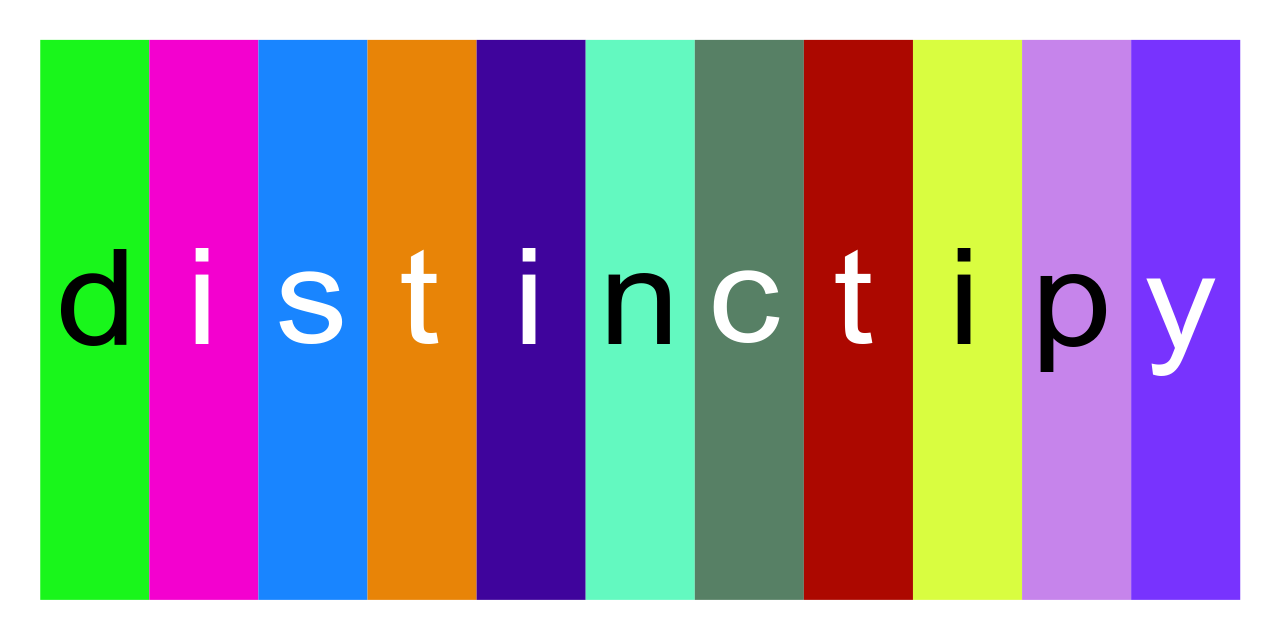distinctipy is a lightweight python package providing functions to generate colours that are visually distinct from one another.
Commonly available qualitative colormaps provided by the likes of matplotlib generally have no more than 20 colours, but for some applications it is useful to have many more colours that are clearly different from one another. distinctipy can generate lists of colours of any length, with each new colour added to the list being as visually distinct from the pre-existing colours in the list as possible.
distinctipy is designed for Python 3 and can be installed with pip by running:
python -m pip install distinctipyAlternatively clone the repo and install it locally:
git clone https://github.com/alan-turing-institute/distinctipy.git
cd distinctipy
python -m pip install .Starting in version 1.2.1 distinctipy no longer bundles matplotlib, pandas or dev dependencies in the default installation. If you wish to view
colours (e.g. with distinctipy.color_swatch) or examples you will need matplotlib and pandas installed. To do this, either install distinctipy
with the optional flag:
python -m pip install distinctipy[extras][optional] instead of [extras].
Or install them separately:
python -m pip install matplotlib pandasFor developers, to install the stack needed to run tests, generate docs etc. use:
python -m pip install distinctipy[extras,tests,docs]distinctipy can:
- Generate N visually distinct colours:
distinctipy.get_colors(N) - Generate colours that are distinct from an existing list of colours:
distinctipy.get_colors(N, existing_colors) - Generate pastel colours:
distinctipy.get_colors(N, pastel_factor=0.7) - Select black or white as the best font colour for any background colour:
distinctipy.get_text_color(background_color) - Convert lists of colours into matplotlib colormaps:
distinctipy.get_colormap(colors) - Invert colours:
distinctipy.invert_colors(colors) - Nicely display generated colours:
distinctipy.color_swatch(colors) - Compare distinctipy colours to other common colormaps:
examples.compare_clusters()andexamples.compare_colors() - Simulate how colours look for someone with colourblindness:
colorblind.simulate_colors(colors, colorblind_type='Deuteranomaly') - Attempt to generate colours as distinct as possible for someone with colourblindness
distinctipy.get_colors(N, existing_colors, colorblind_type="Deuteranomaly")
For example, to create and then display N = 36 visually distinct colours:
import distinctipy
# number of colours to generate
N = 36
# generate N visually distinct colours
colors = distinctipy.get_colors(N)
# display the colours
distinctipy.color_swatch(colors)More detailed usage and example output can be found in the notebook examples.ipynb and examples gallery.
distinctipy was heavily influenced and inspired by several web sources and stack overflow answers. In particular:
- Random generation of distinct colours: Andrew Dewes on GitHub
- Colour distance metric: Thiadmer Riemersma at CompuPhase
- Best text colour for background: Mark Ransom on Stack Overflow
- Colourblindness Filters: Matthew Wickline and the Human-Computer Interaction Resource Network (web archive)
If you would like to cite distinctipy, please refer to the upload of the package on Zenodo: https://doi.org/10.5281/zenodo.3985191

